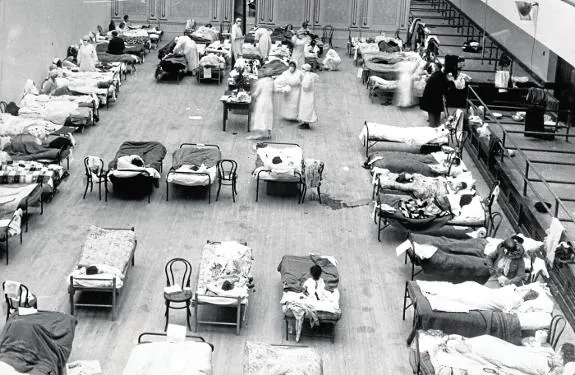The three waves of Spanish Flu
Lethal virus. The pandemic that hit the world a century ago had three phases and infected 25 per cent of the world’s population
ÓSCAR BELTRÁN DE OTÁLORA
Viernes, 15 de mayo 2020, 12:36
Comparing present-day events with those in the past may be tempting, but can be dangerous. In 1918 the modern world suffered its first great pandemic, the so-called Spanish Flu, and it was one of the greatest killers of the 20th century, with an estimated 50 to 100 million people losing their lives. One in every four inhabitants of the planet were infected.
A century later, scientific advances have meant that a disaster such as that cannot repeat itself, but there are still plenty of things about that infection which are not known, and some ideas which are about to be brought back to the table. The origin of the virus is still unknown, as are the real figures about how many people were affected or what the pattern of contagion was like.
Spanish flu hit the world in three waves. Each was different and the final one continued so long that people were still dying from it in 1920.
The first wave
The first wave was in the spring of 1918. The first detected case was in a military camp in Kansas, USA. Scientists call this infection, which spread among the troops who were due to fight in the First World War, the 'herald wave', because it announced the arrival of the others.
The infection spread in Europe once the American troops arrived. In Spain, it was detected around the third week in May. The fact that the press in Spain, which didn't participate in the war, openly reported the epidemic, while the other countries applied war censorship, led the virus to become known as Spanish Flu and it remains permanently associated with this country.
Researchers believe that one of the key places for the spread of the flu was Madrid, where the San Isidro festivities were taking place. Social contacts during the fair multiplied the number of contagions, and even King Alfonso XIII caught it. The government then applied strict confinement measures, which even brought postal deliveries and the telegram service to a halt.
The mortality rate was 0.65 per thousand, and the pandemic lasted for two months. A similar situation occurred in the rest of the world, although South America and Australia were not affected.
The second wave
The second phase of Spanish flu occurred in the autumn of 1918. In Spain, there are several theories about how it spread. Some believe it was because the soldiers doing military service returned home in the summer, or that Portuguese people who returned home by train after the war ended, were to blame. A mutation of the virus has not been ruled out. This time, the number of deaths soared. In some places, summer festivals increased contagion, and churches were ordered to stop ringing their bells at funerals, so people didn't panic about how many there were.
In Zamora, one of the cities most affected, where the mortality rate was triple that in the rest of Spain, the Church helped to spread the disease. Bishop Antonio Álvaro y Ballano claimed it was caused by sin, and started to hold masses to combat the flu. During these, the faithful would kiss the reliquaries of San Roque, patron saint of the sick. The number of new cases shot up. Also, this time, more doctors were affected than during the first phase.
Elsewhere on the planet this second wave was also worse and spread much more. There is no unanimous opinion about where it began, but there is speculation about Liberia, the city of Boston in America or the French port of Brest. In Australia, which had escaped the first wave, the arrival of troops from Europe resulted in 80,000 deaths.
The third wave
Spanish flu returned in the early months of 1919, although this time, generally speaking, it was not as lethal as during the second wave. Scientists suspect that the population had by then developed sufficient immunity for the incidence of the virus to have less effect. In countries such as Japan, for example, the flu was to last until 1920. By the time the illness was over in Spain, eight million people had died.
The state of science at that time meant that certain data is not available. For example, not much was known about the virus until 1933, so the causes of the illness were a mystery in the early 20th century. It has now been established that children between the age of one and three, and people aged between 21 and 30 were most affected most. The place of origin of the virus has never been confirmed, although scientists have suggested three cities: Étaples, in France; Haskell, in the USA, and Xhanxi, in China.
